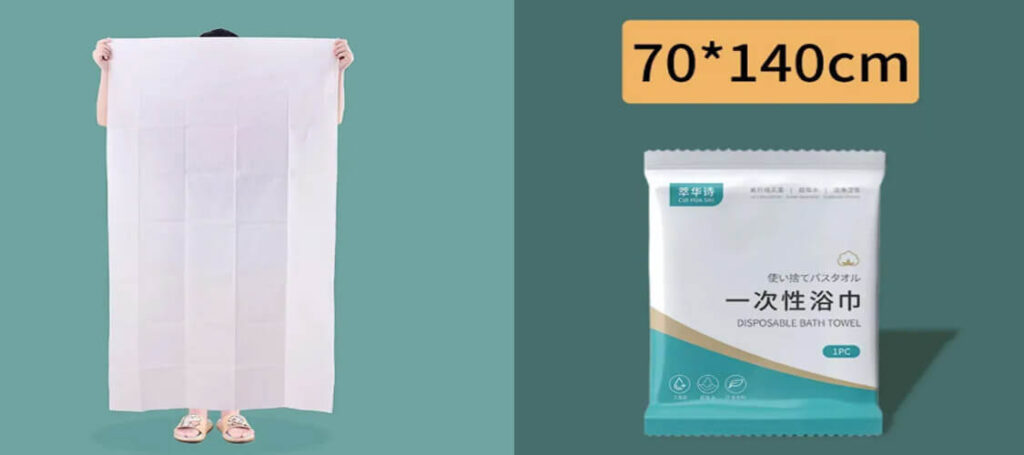When you’re traveling, visiting a gym, or staying in a hotel, the last thing you want to worry about is carrying a towel. That’s where disposable bath towels come in — lightweight, hygienic, and perfectly designed for modern lifestyles. Let’s explore what they are, where they’re used, what materials they’re made from, and how they’re manufactured 🧵
🧺 What Is a Disposable Bath Towel?
A disposable bath towel is a single-use, lightweight, and absorbent towel made from nonwoven fabric. Unlike traditional cotton towels that require washing, disposable bath towels are used once (or a few times) and then discarded.
They’re designed for cleanliness, portability, and time-saving convenience — ideal for people who value hygiene and comfort without the hassle of laundry.
🌍 Common Application Scenarios
Disposable bath towels are widely used across multiple settings:
🏨 Hotels & Guesthouses – for guest hygiene and convenience
✈️ Travel & Business Trips – easy to pack, no need to carry bulky towels
💆 Beauty Salons & Spas – for facial, massage, or body treatments
🏋️ Gyms & Fitness Centers – for personal use after showering
🏕️ Outdoor Activities & Camping – lightweight and quick-drying
🏥 Hospitals & Healthcare – safe, sanitary option for patient care
These towels are especially popular in tourism and hospitality industries where hygiene and efficiency are top priorities.
🧵 Materials Used to Make Disposable Bath Towels
Disposable bath towels are typically made from nonwoven fabrics, which combine softness, strength, and absorbency. Common raw materials include:
- Spunlace Nonwoven Fabric – soft, skin-friendly, and highly absorbent
- Airlaid Paper – excellent absorbency and smooth texture
- Viscose / Rayon – biodegradable and comfortable
- Polyester (PET) – enhances strength and durability
- Cotton or Bamboo Fiber (eco-friendly option) – breathable and natural feel
Some manufacturers even blend natural and synthetic fibers to balance absorbency, strength, and cost.
📏 Standard Sizes of Disposable Bath Towels
Sizes vary depending on usage and market demand, but standard dimensions include:
| Type | Size (cm) | Application |
|---|---|---|
| Adult Bath Towel | 70 × 140 cm / 80 × 160 cm | Hotels, travel, spa use |
| Spa / Salon Towel | 60 × 120 cm | Beauty care, massage |
| Kids Towel | 50 × 100 cm | Children’s use, travel |
| Compressed Bath Towel | Expandable from 6 × 3 cm tablet form | For compact packaging and travel kits |

Manufacturers can customize sizes and GSM (grams per square meter) depending on absorbency and feel.
🏭 How Disposable Bath Towels Are Made
Disposable bath towels are typically produced using an Automatic Disposable Bath Towel Folding & Packing Machine.
The process involves several steps:
- Nonwoven Fabric Unwinding – raw rolls of fabric are fed into the machine
- Folding & Cutting – towels are automatically folded to the desired size
- Spraying or Moistening (optional) – for specific wet towel types
- Counting & Stacking – precise automatic counting system
- Packaging & Sealing – the machine packs towels into bags or pouches for hygiene
Advanced machines can achieve high production efficiency and ensure uniform folding, helping factories maintain clean, consistent quality.
💡 Why Disposable Bath Towels Are Gaining Popularity
- ✅ Hygienic: Single-use, no bacterial contamination
- 🚀 Convenient: No washing or drying required
- 🌿 Eco Options Available: Biodegradable and recyclable materials
- 💰 Cost-Effective: Reduces laundry costs in hotels and salons
- 🧳 Portable: Perfect for travel and outdoor use
With more travelers and hygiene-conscious consumers worldwide, disposable bath towels are becoming a modern essential.
✨ Final Thoughts
Disposable bath towels are more than a travel convenience — they represent a shift toward smarter, cleaner living. Whether you’re running a hotel, spa, or manufacturing plant, understanding the materials, sizes, and machinery behind these products helps you deliver better quality and customer satisfaction 🌟
